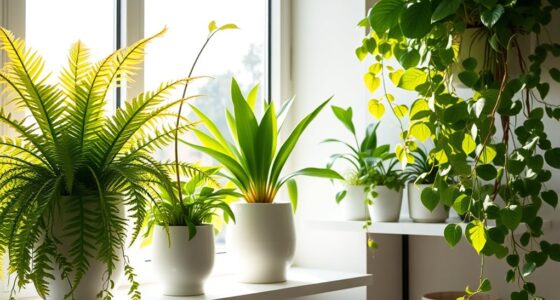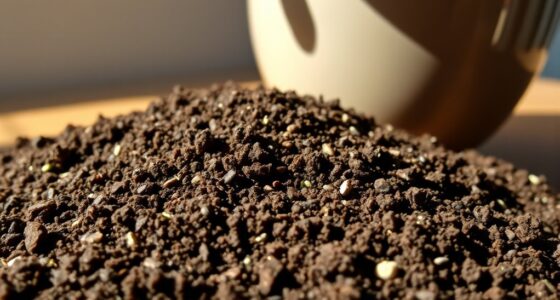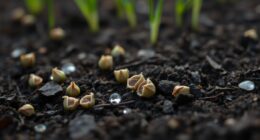To tell if you’re overwatering, look for yellow, wilting leaves and soggy soil, which can lead to root rot. For underwatering, the signs include crispy, brown leaves and dry soil that pulls away from the container edges. Adjust your watering based on what your plant needs—fingers or moisture meters can help. By understanding these clues, you’ll learn how to save your plant and keep it thriving.
Key Takeaways
- Check soil moisture: soggy soil indicates overwatering, while dry, cracked soil suggests underwatering.
- Observe leaf appearance: yellow and wilted leaves often mean overwatering; crispy, brown leaves indicate underwatering.
- Assess root health: rotting roots show overwatering; dry, brittle roots point to underwatering.
- Adjust watering based on plant needs and environmental conditions, using moisture checks for accuracy.
- Prevent problems by tailoring watering schedules to specific plant types and monitoring soil regularly.

Many gardeners struggle to find the right balance between overwatering and underwatering their plants, but understanding the signs can make all the difference. One of the most important factors in maintaining healthy plants is ensuring proper soil drainage. If your soil retains too much water, roots can become waterlogged, leading to root rot and other issues. Conversely, soil that drains too quickly might not hold enough moisture for your plants to thrive, causing them to dry out. To prevent these problems, you need to assess your soil’s drainage capabilities and amend it if necessary, perhaps by adding organic matter or sand to improve water movement.
Establishing a consistent watering schedule is equally *essential*. Many people tend to water on a fixed timetable, but the right schedule depends on your plant type, environmental conditions, and soil characteristics. Overwatering often occurs when you water too frequently, assuming that the soil needs constant moisture. This can lead to soggy soil and unhealthy roots. Underwatering, on the other hand, happens when you water too infrequently, letting the soil dry out completely. Recognizing the signals of each mistake helps you adjust your approach. For instance, if your plant’s leaves are yellow and wilting despite moist soil, you might be overwatering. If leaves become crispy and brown with dry soil, underwatering is likely the *culprit*.
Additionally, understanding the importance of proper soil moisture can greatly improve your plant care routine. To fine-tune your watering routine, check the soil moisture regularly using your finger or a moisture meter. This way, you won’t rely solely on the calendar but on the actual needs of your plants. Remember, different plants have different requirements: succulents prefer infrequent watering, while ferns need consistently moist soil. Adjust your watering schedule accordingly, aiming to keep the soil evenly moist but not soaked. Also, consider the weather—hot, windy days increase evaporation, so your plants may need more water, while cooler, humid days reduce their demand.
Frequently Asked Questions
How Does Soil Type Affect Watering Needs?
Soil type directly impacts your plant’s watering needs because it affects drainage and watering frequency. Sandy soils drain quickly, so you’ll need to water more often to keep roots moist, while clay soils retain moisture longer, requiring less frequent watering. Understanding your soil’s drainage helps prevent overwatering or underwatering, ensuring your plant gets the right amount of water. Adjust your watering schedule based on soil type for healthier, happier plants.
Can Watering Habits Change With Seasonal Variations?
Yes, your watering habits should modify with seasonal variations. You need to adjust your watering schedule based on the season, watering less in winter when plants grow slower, and more during active growth in spring and summer. Keep an eye on soil moisture levels to avoid overwatering or underwatering, and make seasonal adjustments to keep your plants healthy year-round. Proper watering ensures they thrive in every season.
What Are Signs of Root Rot Due to Overwatering?
Did you know root rot is responsible for 85% of plant losses? If you notice your plant’s roots are dark, mushy, or emit a foul odor, it’s a sign of root decay from overwatering. Fungal infection often causes this, leading to damaged roots that can’t absorb nutrients. To save your plant, reduce watering, improve drainage, and remove affected roots to prevent further fungal infection.
How Can I Adjust Watering for Newly Transplanted Plants?
To adjust watering for newly transplanted plants, you should start with a gentle approach to reduce transplant shock. Water less frequently, allowing the soil to dry slightly between waterings, and establish a consistent watering schedule. Keep an eye on the soil moisture and avoid overwatering, which can cause root rot. This helps your plant recover and adapt, ensuring healthy growth and minimizing stress during this critical progression.
Are There Specific Tools to Measure Soil Moisture Accurately?
Yes, there are specific tools like soil moisture meters that give you quick, accurate readings of your soil’s moisture level. You can also do DIY moisture tests by sticking your finger about an inch into the soil; if it feels dry, water is needed. Using these methods, you can better monitor your plant’s needs, preventing overwatering or underwatering and keeping your plant healthy.
Conclusion
Knowing whether you’re overwatering or underwatering can be tricky, but paying close attention to your plant’s signals makes all the difference. Remember, healthy roots need just the right amount of moisture to thrive. Are you really helping your plant by guessing, or are you giving it what it truly needs? By observing its leaves and soil, you’ll become confident in your watering habits and keep your plant happy and lively. Isn’t a thriving plant worth the effort?









